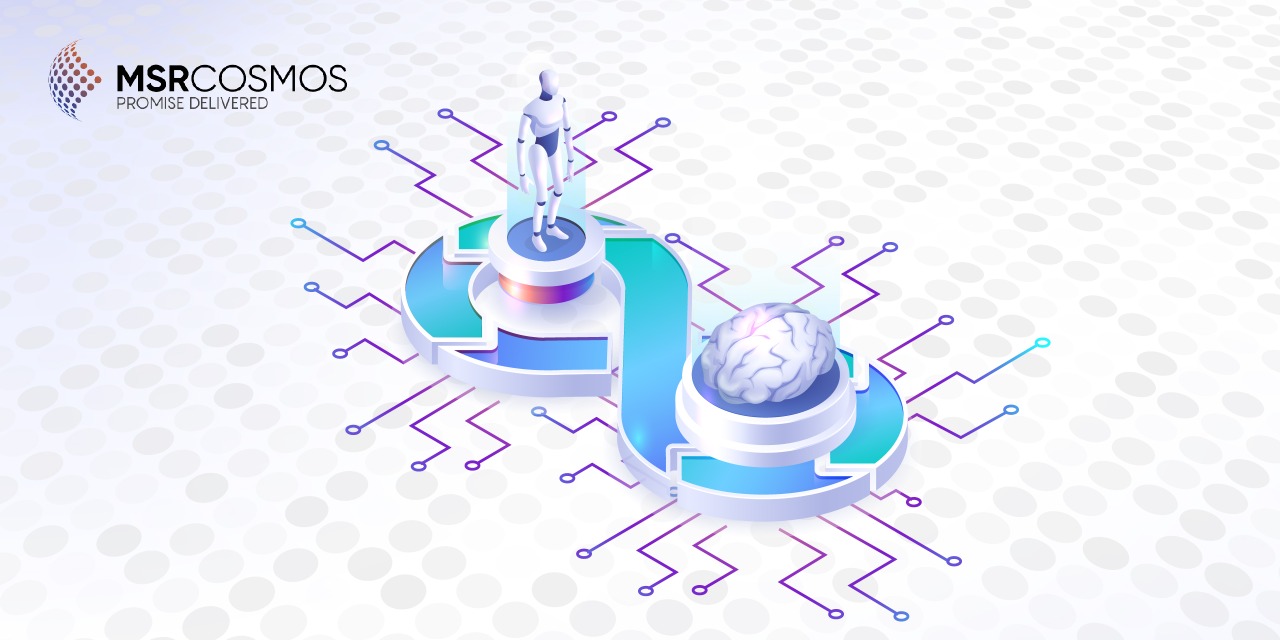- Blog
- February 4, 2022
Applying Machine Learning in DevOps

- Blog
- February 4, 2022
Applying Machine Learning in DevOps
Machine learning (ML) in DevOps along with predictive analytics, IT operations analytics (ITOA), algorithmic IT Operations (AIOps), and artificial intelligence (AI) can create a powerful synergy. But what does that mean? Successful DevOps practices can generate lots of data which can be then used to streamline workflows, better monitoring and production, and for finding out faults among other things. But the problem is that there might sometimes be too much data. The data might cause server logs that might take a week to resolve. The data can be easily created. While using a monitoring tool itself, the team using the tool can create several gigabytes of data in very little time.
The abundance of data
Too much-scattered data results in a lack of foresight. When there is too much data, the teams do not look directly at the conclusion drawn by the data but rather look at thresholds that might showcase problematic activities. Even teams with an abundance of experience are looking for problems and exceptions that deeply analyze the data in front of them. However, it is important to know what you are looking for before you start looking for it, so this behavior makes sense. But it becomes difficult to analyze large amounts of data generated by DevOps.
Introducing machine learning in DevOps
A lot of the data created by DevOps processes are relevant to application deployment. While creating records monitoring of an application, there are several server logs, error messages, and transaction traces created as many times as needed. Machine learning (ML) in DevOps can help you analyze the data in a meaningful and reasonable way.
As stated earlier, DevOps teams rarely look closely at data and instead focus on thresholds that satisfy certain conditions for actions. When they do this, DevOps teams are unable to use the large data that they collect. They entirely focus on outliers which can trigger alerts of certain problems but do provide the much-needed information. When you induce ML in DevOps processes, you can be rest assured of your data getting monitored and analyzed at a continuous pace. ML applications can look at the data along with predictive analytics to draw out meaningful insights.
Once this setup is arranged, we can then look for trends and better forecasts rather than scouting for faults. Once all the data is trained, the ML system can output more than problems. Instead, DevOps workers can now identify the trends over time that might become significant.
The key essence of Machine learning in DevOps
A lot of the data is time-sensitive, and it is also time-series in nature. So, it becomes easy to look at a single variable over time. If there are too many transactions going on at the same time, the response time may become slow as we are doing the same thing at the same time. It becomes difficult to spot these trends through our naked eye. Even traditional analytics are not helpful. Instead, machine learning DevOps applications that are well-trained can tease out correlations and trends.
Data can be generated from the continuous integration system on delivery velocity, identified bugs, metrics, and other related events. Do several bugs found have a connection to the number of integrations? The possibilities for looking at any combination of data are tremendous so we can look at development metrics in a new way with Machine Learning in DevOps.
It is difficult to learn from mistakes with DevOps. Even with an ongoing feedback strategy, we might not have more than a wiki that describes problems we’ve encountered and what we did to investigate them. We might have rebooted our servers or restarted the application to solve the problems and errors. Machine learning DevOps applications can analyse the data to produce the reason for what went wrong over a day, month, or year. No matter if it is a seasonal trend or a daily trend, it can analyse and pick up information at any given moment.
Speeding development with innovation
Many teams fail to fully investigate an issue and get to the root cause as they do not have time and need to get back online. If simple solutions like reboots can get them back online, they avoid the root cause. With machine learning in DevOps, workers can get to the root cause of the issue, letting themselves fix issues once and for all, whether they are about performance or availability.
Wrapping up
With rising ranks in DevOps, workers can look at and use more tools to view data and act upon it. Each tool will then be used to check the health and performance. But how do you find the relationship between all this data? You won’t. Instead, learning systems can take the data streams as inputs, and produce a more robust picture of application health than it is available today. If there are metrics relevant to the orchestration process and tools, machine learning can determine how the team is performing and if they are performing efficiently enough. If there are inefficient processes or actions, then you can find the root cause. Looking at the inefficiencies can help both the processes and tools.
Machine learning in DevOps tools can also help to predict a fault in the future. The tool can relate to analyzing trends. It can also help to optimize a specific metric or goal. Learning through iteration and using neural networks, which most machine learning systems do, are important parts of using machine learning in DevOps.
Ask for a free assessment of your Machine Learning in DevOps maturity by MSRcosmos. Contact us to help you design the roadmap to realize the full benefits of Applying Machine Learning (ML) in DevOps.




